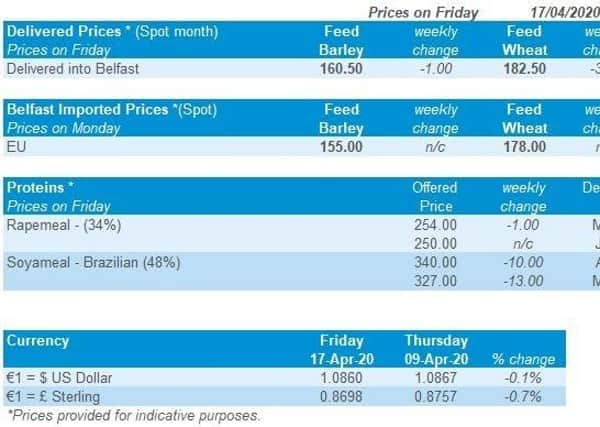Northern Ireland Weekly Market Report


Grains
Wheat
Wheat is generally under pressure, both globally and domestically. However, the risk of Russian export restrictions that could come into force during May has provided short-term support.
Maize
The continued lack of demand for ethanol has maintained pressure on maize prices, combined with an Argentine harvest that is ahead of average and weakened South American currencies.
Barley
Advertisement
Advertisement
Barley remains under pressure with expectations for large supplies in 2020/21, both domestically and in continental Europe.
Global Markets
Maize continues to be under pressure, losing yet more ground last week. From Thursday 9 to Friday 17 April, Chicago maize (May-20) fell $3.74/t. Depressed demand for ethanol has maintained its burden on maize, which until restrictions are lifted and fuel demand returns, will keep US maize prices weak.
Crude oil markets have also come under pressure once more, having found previous support from announced planned cuts to production (read more below).
Further pressure for global grains and maize in particular, comes from South America, where the ethanol industry has also come under pressure as demand has fallen. Also, in the wake of global economic turmoil, the value of the Brazilian real and Argentine peso have both weakened further since the start of March. The harvest in Argentina is also ahead of last year and production estimates of 50Mt are the second highest on record, further adding to a well-supplied global market.
Advertisement
Advertisement
Wheat also continued to be under pressure for most of last week, May-20 Chicago wheat lost a further $9.83/t, Thursday-Thursday. However, markets rallied on Friday and into today as Black Sea wheat prices rise in response to export limitations.
Export restrictions by Russia to maintain domestic wheat supplies could well start to restrict grain exports during May, if the current export pace is maintained, and last until July. There has been a 7Mt limit enacted by for Russian grain exports for April to June, and once the quota has been reached, exports may well halt. With the available supply effectively reduced, prices have been supported. With increasing Black Sea prices, last week France won the majority (180Kt) of the latest Egyptian tender for 240Kt milling wheat.
UK focus
UK feed wheat futures (May-20) ended the week lower, losing £9.20/t, 9 April to 17 April. New crop (Nov-20) also lost ground but to a lesser extent, down £4.70/t. With old crop coming under more pressure than new crop, the spread between the two contracts reached a high of £14.80/t on Friday.
Amid global downturns, the value of the pound has now recovered much of the losses sustained in March. From 9 to 17 April, the pound strengthened a further 0.7% against the euro, closing at £1=€1.1497 on Friday 17 March and up 0.6% against the dollar at £1=$1.2486. The gains in the value of the pound further extenuated the global loss in wheat markets last week.
Advertisement
Advertisement
Following strong demand for bread wheat during March, demand has reduced, and delivered premiums to UK futures have fallen back slightly in April. By 16 April May delivery bread wheat premiums for the North West stood at £36.50/t, from a recent high of £38.55/t on 12 March.
Oilseeds
Rapeseed
Heavy global oilseed supplies continue to weigh on rapeseed prices, more than offsetting worries about dry weather in northern Europe for now.
Soyabeans
Lower demand due to the coronavirus is combined with a large Brazilian harvest to keep markets well supplied.
Global Markets
Global oilseed prices were pushed lower again last week by worries about the impact of the coronavirus pandemic on demand.
Advertisement
Advertisement
Brent crude oil futures dropped back below $30/barrel, as more organisations lowered demand forecasts due to lockdowns around the world. Reduced fuel demand is hitting demand for biodiesel, and so vegetable oils. Also last week, Malaysia delayed the introduction of a higher (B20) biodiesel blend due to the pandemic.
US export sales of soyabeans remain sluggish. Despite strong crush demand in March, the pace of exports is exacerbating concerns that the 2019/20 US stocks may rise even further.
Adding further pressure, the Brazilian soyabean harvest is 89% complete (AgRural). This brings increasing confidence that a large crop (currently estimated at 123.8Mt) will be realised.
On a more positive note, China expects to import 92.5Mt of soyabeans this year and 99.5Mt annually by 2029. These figures, out this morning, would represent a recovery after the country’s pig herd was badly hit by African Swine Flu. Pork imports are also expected to be up 33% this year.
Advertisement
Advertisement
Argentina’s soyabean production is now pegged at 50.5Mt in 2019/20 by the Rosario Grain Exchange, due to dry weather last month. This is 1.0Mt lower than previously forecast but still higher than the 49.5Mt the Buenos Aries Grain Exchange expects, with 38% of the crop harvested. In 2018/19 the country produced 56.5Mt.
Rapeseed focus
Paris rapeseed futures (Nov-20) declined €2.25/t between 9 and 17 April, to close at €372.00/t. The contract followed the global oilseed trend but to a lesser extent as the euro edged down against the US dollar. May-20 prices gained slightly, potentially due to technical factors before the contract finishes trading on 30 April.
UK delivered prices were also lower Thursday - Friday. Trade is said to remain quiet as field work remains a priority on farm.
German winter rapeseed production was forecast at 3.34Mt last week, by the country’s association of farm cooperatives. This is 100Kt lower than last month’s estimate, due to late winter frosts but still 18% larger than last year’s drought affected crop.
Data out this week: Canadian canola planting intentions on Friday (24 April).